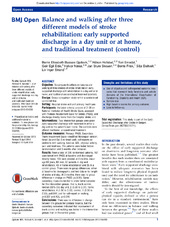| dc.description.abstract | Objective: To compare the effects on balance and walking of three models of stroke rehabilitation: early supported discharge with rehabilitation in a day unit or at home, and traditional uncoordinated treatment (control). Design: Group comparison study within a randomised controlled trial. Setting: Hospital stroke unit and primary healthcare. Participants: Inclusion criteria: a score of 2–26 on National Institutes of Health Stroke Scale, assessed with Postural Assessment Scale for Stroke (PASS), and discharge directly home from the hospital stroke unit. Interventions: Two intervention groups were given early supported discharge with treatment in either a day unit or the patient’s own home. The controls were offered traditional, uncoordinated treatment. Outcome measures: Primary: PASS. Secondary: Trunk Impairment Scale—modified Norwegian version; timed Up-and-Go; 5 m timed walk; self-reports on problems with walking, balance, ADL, physical activity, pain and tiredness. The patients were tested before randomisation and 3 months after inclusion. Results: From a total of 306 randomised patients, 167 were tested with PASS at baseline and discharged directly home. 105 were retested at 3 months: mean age 69 years, 63 men, 27 patients in day unit rehabilitation, 43 in home rehabilitation and 35 in a control group. There were no group differences, either at baseline for demographic and test data or for length of stroke unit stay. At 3 months, there was no group difference in change on PASS ( p>0.05). Some secondary measures tended to show better outcome for the intervention groups, that is, trunk control, median (95% CI): day unit, 2 (0.28 to 2.31); home rehabilitation, 4 (1.80 to 3.78); control, 1 (0.56 to 2.53), p=0.044; and for self-report on walking, p=0.021 and ADL, p=0.016. Conclusions: There was no difference in change between the groups for postural balance, but the secondary outcomes indicated that improvement of trunk control and walking was better in the intervention groups than in the control group. | en_US |

